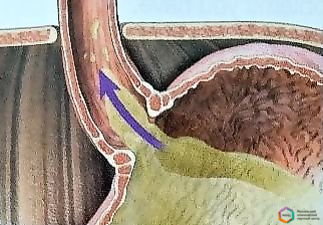Hernia of the esophageal orifice of the diaphragm
Hernia of the esophageal orifice of the diaphragm (GPOD) - displacement of the abdominal part of the esophagus and stomach into the thoracic cavity through the esophageal opening of the diaphragm.

Complications of GERD:
- Erosions and ulcers of the esophagus.
- Esophageal stricture.
- Baret's esophagus (precancerous condition).
- Infringement of the abdominal organs (with paraesophageal hernias).
The spread of GERD worldwide is from 8-27. 8 % per 100 thousand people.
In Russia, it is 23.7 % per 100 thousand people.

A) Sliding-part of the esophagus and stomach in a vertical position returns to the abdominal cavity.
B) Fixed-part of the esophagus and stomach remain in the chest cavity (fixed by spikes).
A) Cardiac-only the cardiac part of the stomach is displaced.
B) Cardiofundal – the cardiac department and the bottom of the stomach are displaced.
C) Subtotal-2/3 of the stomach is located above the diaphragm.
D) Total-the entire stomach is located above the diaphragm.
E) Paraesophageal-the cardiac part of the stomach remains in the abdominal cavity, and the abdominal organs (stomach, colon, large omentum) are displaced above the diaphragm.
Risk factors.
- Increased body weight.
- Eating fatty foods, coffee, and carbonated drinks.
- The use of alcoholic beverages.
- Smoking.
Symptoms.
1. Esophageal symptoms.
- Heartburn.
- Belching, regurgitation (abandonment of previously eaten food).
- Dysphagia.
2. Extraesophageal symptoms.
- Coughing and wheezing.
- Hoarseness, sore throat.
- Otitis media.
- Non-cardiac chest pain.
- Erosion of tooth enamel and other manifestations on the part of the teeth.
- Anemia.
Diagnostics.
- X-ray examination with a contrast agent (polypositional).
- EGDS (if necessary, taking a biopsy).
- Esophageal manometry (study of esophageal motility).
- Daily pH-metric.
Treatment.

The main method of treatment is complex drug therapy.
If the course of therapy is ineffective and there are complications, surgical treatment is indicated.
The operation aimed at eliminating reflux is called fundoplication.
The main types of fundoplications:
1. Fundoplication by Nissen, by A. F. Chernousov (fundoplication 360* circular).
2. Fundoplications by Toupet (fundoplications 270* partial).
The choice of the type of fundoplication is carried out only after a comprehensive diagnostic examination.
Employees of the Department of High-tech Surgery of the Loginov Moscow Medical Research Center perform these operations from low-traumatic approaches (laparoscopic operations, robotic operations).
The postoperative period is 1-2 days.
The rehabilitation period is 1-1. 5 weeks. 





